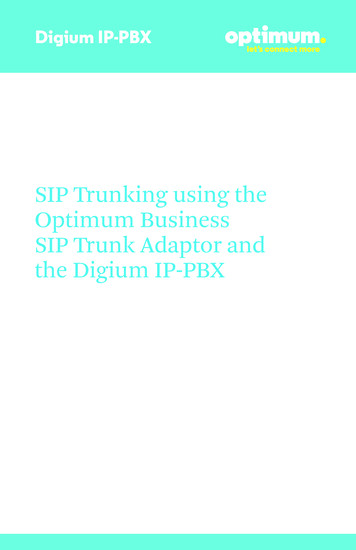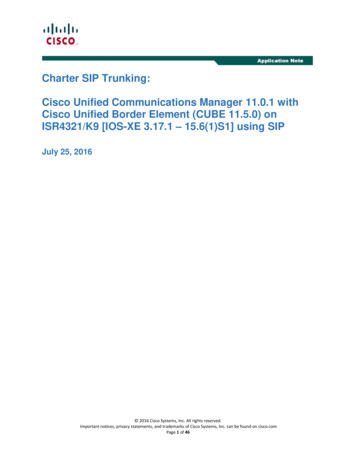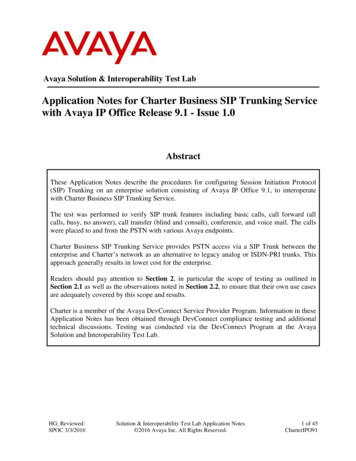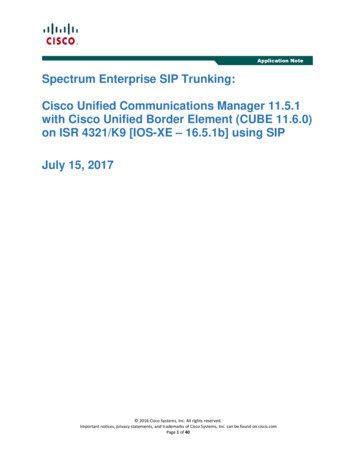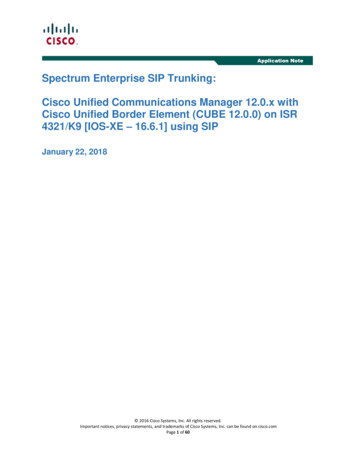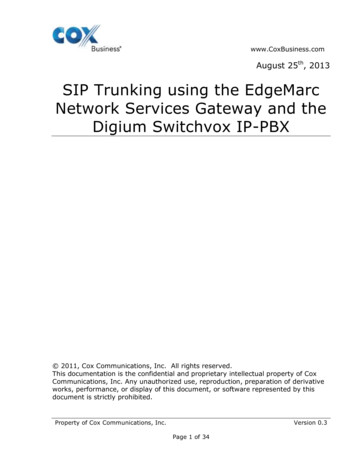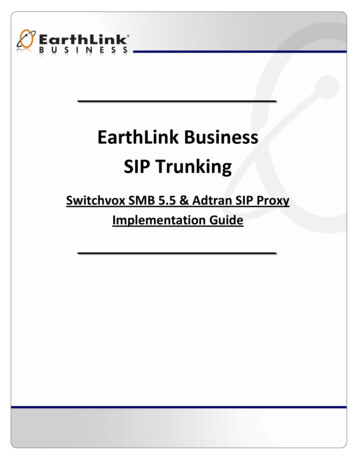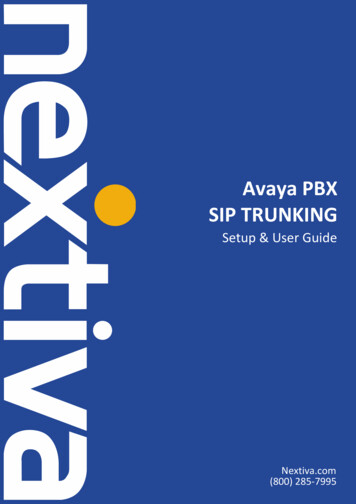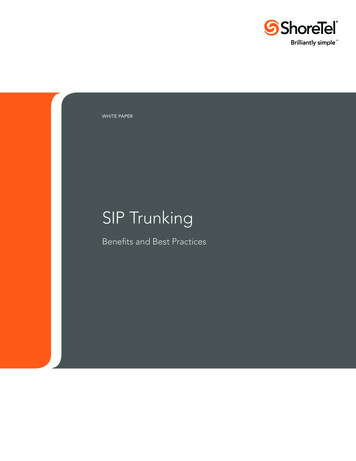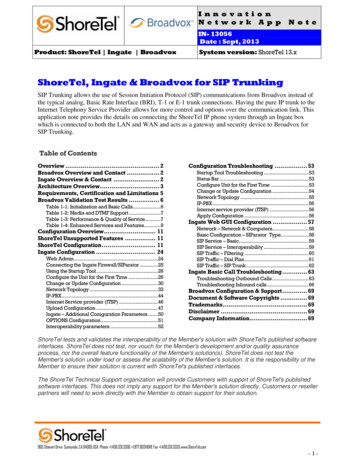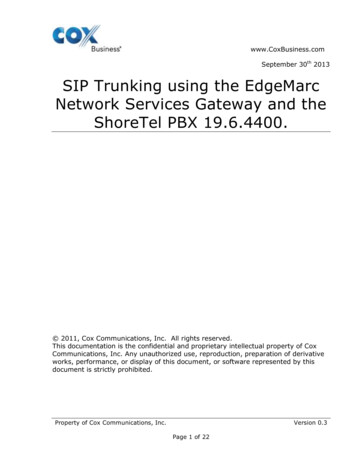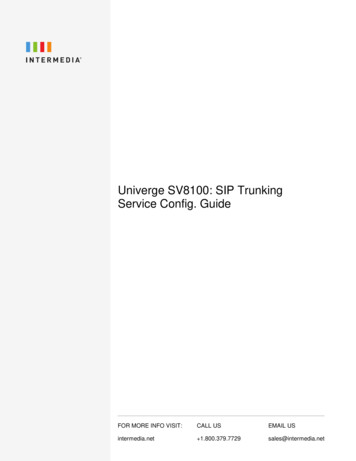
Transcription
Univerge SV8100: SIP TrunkingService Config. GuideFOR MORE INFO VISIT:CALL USEMAIL USintermedia.net 1.800.379.7729sales@intermedia.net
2 Univerge SV8100: SIP Trunking Service Config. GuideINTRODUCTIONChapter 1 Configuring NEC SV8100 with Intermedia SIP . 4Section 1 NEC SV8100 and Intermedia Setup Guide . 41.1 This Guide and Related Documents . 41.2 Intermedia Account . 41.3 SV8100 System Software . 41.4 Requirements . 41.5 Limitations . 5Section 2 NEC PBX Configuration . 52.1 Prerequisites. 52.1.1 SIP Trunking Information from Intermedia . 52.1.2 NEC UNIVERGE SV8100 . 52.1.3 Installation Worksheet . 5Section 3 SV8100 Programming . 63.1 Trunk Type / Slot Configuration . 73.2 CD-CP00 Network Setup . 83.3 IPLA/IPLB DSP Basic Setup . 103.4 SIP System Information Setup . 123.5 SIP Server Information Setup. 133.6 SIP Authentication Information Setup . 153.7 IP System Interconnection Setup . 163.8 Calling Party Information (Trunk) . 163.9 Class of Service Options (Outgoing Call Service) . 173.10 IP Trunk Calling Party Number Setup . 193.11 IP Trunk (SIP) Calling Party Number Setup for Extensions. 193.12 DID (TN to ext map) . 203.13 DTMF Configuration . 203.14 ToS Setup . 223.15 SIP Trunk Basic Setup . 23Section 4 Initial Testing and Troubleshooting . 24
3 Univerge SV8100: SIP Trunking Service Config. GuideLIST OF FIGURES AND TABLESTable 1Installation Worksheet . 6Figure 1Blade Configuration . 7Figure 2IPLA/IPLB Configuration . 7Figure 3IPLA/IPLB DSP Resource Selection . 8Figure 4IP Trunk Availability . 8Figure 5CD-CP00 Network Setup . 9Figure 6IPLA/IPLB DSP Basic Setup . 10Table 2Port Table . 11Table 3Router Forwarding (Gateway Table) . 12Figure 7SIP System Information Setup . 12Figure 8SIP Server Information Setup . 14Figure 9SIP Authentication Information Setup . 15Figure 10IP System Interconnection Setup . 16Figure 11Class of Service Options . 18Figure 12IP Trunk (H.323/SIP) Calling Party Number Setup for Trunks . 19Figure 13IP Trunk (SIP) Calling Party Number Setup for Extensions . 19Figure 14Incoming Call Trunk Setup . 20Figure 15SIP Trunk Codec Setup . 21Figure 16SIP Trunk Codec Setup (Continued) . 22Figure 17ToS Setup . 23Figure 18SIP Trunk Basic Setup . 24Table 4Troubleshooting Guide . 25
4 Univerge SV8100: SIP Trunking Service Config. GuideCONFIGURING NEC SV8100 WITH INTER MEDIA SIPTRUNKING SERVICESECTION 1 NEC SV8100 AND ACCESSLINE SETUP GUIDE1.1This Guide and Related DocumentsThis guide was created to assist knowledgeable vendors with configuring theNEC SV8100 Communication Server with Intermedia’s SIP Trunking service. Itprovides sample entries for the required fields. The actual data is provided byIntermedia when service is activated. Questions about software and hardwareinstallation or other PBX configuration issues should be directed to NEC’sNational Technical Assistance Center (NTAC).For complete details on using SIP trunks with the SV8100, refer to the SV8100Networking Manual.For complete details on using DID features, refer to the DID feature in theSV8100 Features and Specifications Manual.For details about related hardware, refer to the SV8100 System HardwareManual.These manuals can be downloaded from NEC’s National Technical AssistanceCenter (NTAC) web site. You must have a valid dealer ID to access thedocuments.Note: Intermedia SIP Trunking Service does not support the T.38 protocol forFAX over IP (FoIP).1.2Intermedia AccountContact your Intermedia representative.1.3SV8100 System SoftwareThe SV8100 requires system software Version 5.02 or higher to use Intermediaservice.1.4RequirementsWith the SV8100, a VoIP gateway daughter board is required in addition tolicensing for IP (SIP) trunks.A minimum of four IP (SIP) trunks are required due to the NEC CommunicationsServer infrastructure setup.
5 Univerge SV8100: SIP Trunking Service Config. GuideThe system software for the NEC Communications Server should be Version5.02 or higher.NEC recommends that the requirements and programming are completed withas much information as possible before scheduling an activation appointmentwith Intermedia.1.5LimitationsThe following limitations apply: Some private IP network ranges conflict with SIP trunking serviceproviders’ ranges. This can cause issues when connecting to the SIPtrunking service provider. Private ranges reserved for the customer’s LANare:10.x.x.x192.168.0.x through 192.168.10.xSECTION 2 NEC PBX CONFIGURATIONThis section provides information to NEC’s solution providers and NECAssociates for configuring an NEC UNIVERGE SV8100 to connect to aIntermedia SIP Trunk service provider, utilizing a DYNAMIC configuration.2.1 PrerequisitesBefore you configure the UNIVERGE SV8100, you must have the followinginformation available.2.1.1 SIP Trunking Information from Intermedia Primary SIP Proxy Server IP AddressNumber Plan, if applicable for the Point-to-Point ConnectionTrunking DID(s) The DID(s) are forwarded to the Public WAN IPaddress(s), DNS or DNS SRV records of the PBX.2.1.2 NEC UNIVERGE SV8100 SV8100 CPU firmware Version 5.02 or higherIPLA/B (PZ-XX)SIP Trunking License (minimum of four licenses)Digital, IP and TDM Telephones
6 Univerge SV8100: SIP Trunking Service Config. Guide2.1.3 Installation WorksheetUse the worksheet to record the information needed for setting up the SIPTrunking service.Table 1 Installation WorksheetWAN Side:Internet Access Type and Speed:WAN IP Address:WAN Subnet Mask:WAN Gateway IP Address:LAN Side:LAN IP Address for SIParator orEdgeMarc:LAN Subnet Mask:LAN IP Address for SV8100:VLAN ID:PBX Information:Model:Firmware Version:Number of SIP Trunk Licenses:Add-on Software Applications:Number of Users:Number of Concurrent Calls:Notes:SECTION 3 SV8100 PROGRAMMINGWhen using Intermedia as your SIP trunking service provider, the followingprograms must be changed for SIP trunking service.
7 Univerge SV8100: SIP Trunking Service Config. GuideWhen using PCPro or WebPro for programming, enabling an option may be acheckbox option rather than entering a ‘1’ as in terminal programming.3.1 Trunk Type / Slot ConfigurationFigure 1. Blade ConfigurationFigure 2. IPLA/IPLB Configuration10-03-02: Blade Setup, for IPLA/IPLB (VoIPDB)Define the trunks to be used for SIP trunks as 1 (SIP).
8 Univerge SV8100: SIP Trunking Service Config. GuideFigure 3. IPLA/IPLB DSP Resource Selection10-19-01: VOIP DSP Resource SelectionSpecify the operating mode for the DSP resources (0 common use (extensionsand trunks), 1 IP extensions only, 2 SIP trunks only, 3 CCIS, 4 NetLink,5 Blocked, 6 Unicast, 7 Multicast, 8 Paging).Figure 4. IP Trunk Availability10-40-1: IP Trunk Availability – IP Trunk AvailabilityTurn this option "on".10-40-2 IP Trunk Availability – IP Trunk Port CountSelect the number of trunks being used.
9 Univerge SV8100: SIP Trunking Service Config. Guide3.2 CD-CP00 Network SetupValues shown are for example purposes only. Your actual IP values will bedetermined by your local LAN administrator.Figure 5. CD-CP00 Network Setup10-12-1 CD-CP00 Network Setup – IP AddressSet the LAN IP address for the system ethernet port to 0.0.0.010-12-2 CD-CP00 Network Setup – Subnet MaskSet the subnet mask for the system ethernet port to be different than the subnetfor the IPLA/IPLB blade.10-12-3 CD-CP00 Network Setup – Default GatewaySet the default gateway for the VoIPDB blade.If a router or firewall is placed between the SIP Trunk Provider and SV8100,You must also set the following programs:10-12-6 CD-CP00 Network Setup – NAPT RouterTurn this program on if the SV8100 resides behind a NAT router.10-12-7 CD-CP00 Network Setup – NAPT Router IP AddressSet the WAN IP address of the NAT router behind the SV8100.10-12-09: CD-CP00 Network Setup – IP AddressSelect the IP address for the VoIP connection (default: 172.16.0.10). A static IPaddress is required.
10 Univerge SV8100: SIP Trunking Service Config. GuideIP address is required by the CD-CP00. Some private IP network ranges (ex:192.168.0.0/ 16, 172.16.0.0/12) conflict with SIP Service Provider's Networkranges which may cause issues when connecting SIP connect service. Privateranges reserved for the customer’s LAN are 10.x.x.x and 192.168.0.x through192.168.10.x.The SV8100 must be reset in order for the change to take effect. 10-12-10:CD-CP00 Network Setup – Subnet MaskSelect the Subnet Mask to be used by the VoIP server (default: 255.255.0.0).3.3 IPLA/IPLB DSP Basic SetupValues shown are for example purposes only. Your actual IP values will bedetermined by your local LAN administrator.Figure 6. IPLA/IPLB DSP Basic SetupPort Forwarding:The Router will require port forwarding rules to be configured.Port 5060 must be forwarded to the address entered in Program 10-12-09.Port 5060 is not used for remote terminals - ports 5070 and 5080 are usedinstead. Port 5060 is only used for trunking so there are no issues with thepossible fraudulent usage of unauthorized remote attempts to register remoteterminals.The ports used in Programs 84-26-02 and 84-26-03 must be forwarded tothe IP address entered in Program 84-26-01.The RTP/RTCP ports are forwarded to avoid possible one-way conversationwhich might occur on inbound calls. When forwarding the ports, the range foreach gateway must be set. The number of gateways to forward will depend onthe size of the IPLA/B. Gateway 1 will require ports 10020-10051 forwarded.
11 Univerge SV8100: SIP Trunking Service Config. Guide Gateway 2 will require ports 10052-10083 forwarded. Gateway 3 will require ports 10084-10115 forwarded. Gateway 4 will require ports 10116-10147 forwarded. Gateway 5 will require ports 10148-10179 forwarded. Gateway 6 will require ports 10180-10211 forwarded. Gateway 7 will require ports 10212-10243 forwarded. Gateway 8 will require ports 10244-10275 forwarded.Table 2 Port YesNo
12 Univerge SV8100: SIP Trunking Service Config. GuideTable 3 Router Forwarding (Gateway Table)IPLA/IPLB Size GatewayIPLB32/64/1281IPLA322IPAddressRTP PortRTCPPort3IPLA644567IPLA1288Example: Router configuration shown from the NEC 5.0-10020 10021 10052 10053 10084 10085 10116 10117 5060 10.10.3.10-5060UDP
13 Univerge SV8100: SIP Trunking Service Config. Guide3.4 SIP System Information SetupValues shown are for example purposes only. Your actual values will bedetermined by your implementation team.Figure 7. SIP System Information Setup10-28-1 SIP System Information Setup – Domain NameDefine the Domain name up to 64 characters. This information is specific to yourmarket and is provided by your SIP Trunking Service Provider. When configuring Domain name, the SIP service provider will supply theProxy/Domain in the following manner - "Host Name". "Domain Name". Thecharacters are normally separated by “.” The characters after “.” will be inthe Domain Name.10-28-2 SIP System Information Setup – Host NameDefine the Host name, up to 48 characters. When configuring Host name, the SIP service provider will supply theProxy/Domain in the following manner - "Host Name". "Domain Name". Thecharacters are normally separated by “.” The characters before “.” will be inthe Domain Name.10-28-3 SIP System Information Setup – Transport ProtocolDefine the Transport type. This option is always set to 0 (UDP).10-28-4 SIP System Information Setup – User IDThis information is provided by your SIP Trunking Service Provider.Entries: 32 characters maximum (Default No Entry). Typically the ten digit billing telephone number is used. This entry must benumeric as Program 10-23-04 does not allow text entry - only numeric.10-28-5 SIP System Information Setup – Domain AssignmentDetermine the type of Domain Assignment. Set this entry to 1 (Domain Name).10-28-6 SIP System Information Setup – IP Trunk Port BindingSet this entry to 0 (Disable) to allow an incoming call to use the lowest port.
14 Univerge SV8100: SIP Trunking Service Config. Guide3.5 SIP Server Information SetupValues shown are for example purposes only. Your actual values will bedetermined by your implementation team.Figure 8. SIP Server Information Setup10-29-01: SIP Server Information Setup – Outbound Default ProxyEnable (1) the SIP Outbound Proxy. If entries are made in Program 10-29-xx for a SIP Server and the SIPServer is then removed or not used, the entries in Program 10-29-xx mustbe set back to their default settings. Even if 10-29-01 is set to .0. (off), theSV8100 will check the settings in the remaining 10-29 programs.10-29-03: SIP Server Information Setup – Default Proxy IP AddressDefine the SIP Trunk Service Provider Proxy IP Address. You may resolve theIP address of the Outbound Proxy by pinging the URL.10-29-5 SIP Server Information Setup – Registrar ModeSet the Registrar Mode to 1(manual) with SIP trunking.10-29-6 SIP Server Information Setup – Registrar IP AddressInput the IP address of the SIP registrar (if given).10-29-8 SIP Server Information Setup – SIP Proxy Setup – DNS ModeSet the DNS Mode to 1, when the SIP carrier provides a domain name.10-29-9: SIP Server Information Setup – SIP Proxy Setup – DNS IPAddressThis information should be provided by your SIP service provider. The DNS IP Address should be any valid Domain Name Server either SIPprovided or within your network.
15 Univerge SV8100: SIP Trunking Service Config. Guide10-29-11 SIP Server Information Setup – SIP Proxy Setup – RegistrarDomain NameDefine the Registrar Domain Name. This information should be provided by yourSIP service provider (128 characters maximum).10-29-12 SIP Server Information Setup – Proxy Domain NameEnter the Domain name. When configuring the Domain name, the SIP service provider will supply theProxy/ Domain in the following manner - "Host Name". "Domain Name". Thecharacters are normally separated by “.” The characters after “.” will be inthe Domain Name.10-29-13 SIP Server Information Setup – Proxy Host NameEnter the Host name. When configuring Domain name the SIP service provider will supply theProxy/Domain in the following manner - "Host Name". "Domain Name". Thecharacters are normally separated by “.” The characters before “.” will be inthe Host Name.10-29-14 SIP Server Information Setup – SIP Carrier ChoiceSet the SIP Carrier Choice to 0 (Default).10-29-1 SIP Server Information Setup – Registration Expiry TimeIt is important to leave this automatic re-registration time to be 3600 seconds sothat the Intermedia network does not get flooded.10-29-16 SIP Server Information Setup – Register Sub ModeUnchecking the Register Sub Mode (setting it to “off”) will allow all trunk calls tobe routed based on routing policies.
16 Univerge SV8100: SIP Trunking Service Config. Guide3.6 SIP Authentication Information SetupValues shown are for example purposes only. Your actual values will bedetermined by your implementation team.Figure 9. SIP Authentication Information Setup
17 Univerge SV8100: SIP Trunking Service Config. Guide10-30-2 SIP Authentication Information Setup – User NameDefine the authentication User Name provided by Intermedia as defined inProgram 10-28-04. This information is provided by your SIP Service Provider.Entries: 48 characters maximum. NEC recommends using "nec8100" if this information is not supplied byyour service provider.10-30-3 SIP Authentication Information Setup – PasswordEnter the Intermedia authentication password. This information is provided byyour SIP Service Provider.Entries: 48 characters maximum.
18 Univerge SV8100: SIP Trunking Service Config. Guide3.7 IP System Interconnection SetupValues shown are for example purposes only. Your actual values will bedetermined by your implementation team.Figure 10. IP System Interconnection Setup10-23-1 System InterconnectionEnable interconnection to the SIP Server.10-23-2 IP AddressEnter the IP Address of the SIP Server.10-23-04: Dial NumberEnter the digits to be sent to the SIP Server on an outbound call.
19 Univerge SV8100: SIP Trunking Service Config. Guide3.8 Calling Party Information (Trunk)Caller ID - In the Invite message there are two fields that can have caller ID.One field is the “SIP From Address” and the other field is “SIP Display Info”. Ifboth of these fields are left blank the call will not complete.Below is an example of a SIP Invite Message with outbound CID.From “2142622000” sip:test@172.16.0.100 14-12-1 SIP Register ID Setup for IP TrunksOn a per trunk basis, you can choose a SIP register ID of 0 31. If the ID is leftto 0, the “SIP from Address” would not be assigned on a per trunk basis. If set to1 31, it then looks at command 10-36-02 to populate the “SIP from Address”field.14-12-2 SIP Register ID Setup for IP TrunksThis is for SIP trunks to the provider for inbound purposes. If 10-28-06 (Trunkport Binding) is enabled, inbound calls map to the trunk. If you want to create ahunt group when trunk port binding is enabled, set multiple t
and trunks), 1 IP extensions only, 2 SIP trunks only, 3 CCIS, 4 NetLink, 5 Blocked, 6 Unicast, 7 Multicast, 8 Paging). Figure 4. IP Trunk Availability 10-40-1: IP Trunk Availability – IP Trunk Availability Turn this option "on". 10-40-2 IP Trunk Availability – IP Trunk
